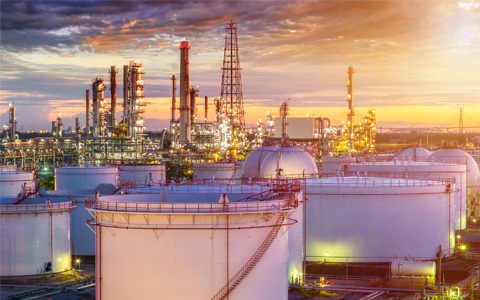Sponsored by:
How Oil and Gas Industry Leaders Are Navigating Carbon Reduction Goals
Oil and gas companies are searching for means to close the gap between ambition and reality
In a new survey conducted by Endeavor Business Intelligence on behalf of NextEra Energy Resources, 76% of leaders at oil and gas companies with operations in the United States say their organization is on track or ahead of its zero-carbon energy use goal. However, the devil is in the details. The survey data reveals significant challenges facing industry efforts to reduce carbon emissions and that companies are still experimenting with a wide range of means to chart a successful journey.
Learn the biggest challenges oil and gas companies face to continue progress toward emissions-reduction goals and how leaders are working to solve them.
Emissions reduction industry progress report
Goals and implementation
Emissions and reduction to date
Coals energy goals and use
Goals and implementation
More than 90% of oil and gas leaders surveyed said their organization has set a goal to reduce emissions and started implementation.
Has your organization set a corporate goal to reduce its greenhouse gas (GHG) emissions?
Which of the following best describes the current stage of your organization’s emissions-reduction journey?
Planning stage
Early implementation stage
Mid-implementation stage
Advanced implementation stage
Base: All respondents (n=175).
Goals and implementation
Emissions and reduction to date
Coals energy goals and use
Emissions and reduction to date
54% of survey respondents said their organizations have cut emissions by at least 11% from baseline.
Which of the following best describes the current stage of your organization’s emissions-reduction journey?
The same or higher relative to the baseline used for our goal
Down 1% to 10% from our baseline
Down 11% to 25% from our baseline
Down 26% to 50% from our baseline
Down more than 50% from our baseline
My organization has achieved net-zero emissions
Base: All respondents (n=175).
Goals and implementation
Emissions and reduction to date
Coals energy goals and use
Coals energy goals and use
Three-quarters of oil and gas leaders said their organization was on track or ahead of its goal for zero-carbon energy use, while 83% said more than a quarter of their organization’s energy use from operations came from zero-carbon energy sources.
What percentage of energy use by operations comes from zero-carbon energy sources?
0 to 25%
26 to 50%
51 to 75%
76 to 100%
How would you describe the percentage of energy use from zero-carbon energy sources at your organization?
Behind our goal for zero-carbon enrgy use
On track with our goal for zero-carbon energy use
Ahead of our goal for zero-carbon energy use
Base: All respondents (n=175).
Macroeconomic environment creates carbon reduction headwinds
Macroeconomic growth trends are impacting U.S. oil and gas industry efforts to continue progress toward emissions-reduction goals.
Oil and gas industry emissions-reduction challenges
Internal uncertainty
Stakeholder pressures
Technical and operational limitations
About two-thirds of leaders surveyed strongly or somewhat agreed that it’s simply too expensive for their company to ever achieve net-zero emissions.
How strongly do you agree or disagree with the following statement?
It is too costly to achieve net-zero emissions at my company.
Base: All respondents (n=175).
Strongly Agree
Somewhat Agree
Neutral
Somewhat Disagree
Strongly Disagree
How strongly do you agree or disagree with the following statement?
Clean energy and other emissions-reduction technologies are still maturing, so my organization wants to wait before investing in more projects.
Base: All respondents (n=175).
Strongly Agree
Somewhat Agree
Neutral
Somewhat Disagree
Strongly Disagree
How strongly do you agree or disagree with the following statement?
My organization is waiting for a technology that is still not widely available (e.g., green hydrogen or small modular nuclear reactors) to make a major investment in reducing emissions.
Base: All respondents (n=175).
Strongly Agree
Somewhat Agree
Neutral
Somewhat Disagree
Strongly Disagree
How strongly do you agree or disagree with the following statement?
There’s too much pricing uncertainty around clean energy and emissions-reduction technologies for my organization to make decisions.
Base: All respondents (n=175).
Strongly Agree
Somewhat Agree
Neutral
Somewhat Disagree
Strongly Disagree
How strongly do you agree or disagree with the following statement?
It’s impossible to electrify or use zero-carbon fuels to conduct my organization’s operations.
Base: All respondents (n=175).
Strongly Agree
Somewhat Agree
Neutral
Somewhat Disagree
Strongly Disagree
Internal uncertainty
Stakeholder pressures
Technical and operational limitations
Oil and gas leaders receive mixed messages from stakeholders. Companies often have many senior leaders and operate across many jurisdictions, meaning they must listen to and account for many differing voices.
How strongly do you agree or disagree with the following statement?
Investors are pressuring my organization to reduce emissions.
Base: All respondents (n=175).
Strongly Agree
Somewhat Agree
Neutral
Somewhat Disagree
Strongly Disagree
How strongly do you agree or disagree with the following statement?
Senior leaders at my organization are creating pressure to accelerate emissions-reduction goals.
Base: All respondents (n=175).
Strongly Agree
Somewhat Agree
Neutral
Somewhat Disagree
Strongly Disagree
How strongly do you agree or disagree with the following statement?
My organization is facing federal/state political pressure to accelerate emissions-reduction goals.
Base: All respondents (n=175).
Strongly Agree
Somewhat Agree
Neutral
Somewhat Disagree
Strongly Disagree
How strongly do you agree or disagree with the following statement?
Customers are pressuring my organization to reduce emissions.
Base: All respondents (n=175).
Strongly Agree
Somewhat Agree
Neutral
Somewhat Disagree
Strongly Disagree
How strongly do you agree or disagree with the following statement?
My organization is facing federal/state political pressure to roll back or cancel emissions-reduction goals.
Base: All respondents (n=175).
Strongly Agree
Somewhat Agree
Neutral
Somewhat Disagree
Strongly Disagree
How strongly do you agree or disagree with the following statement?
Senior leaders at my organization are creating pressure to roll back or cancel emissions-reduction goals.
Base: All respondents (n=175).
Strongly Agree
Somewhat Agree
Neutral
Somewhat Disagree
Strongly Disagree
Internal uncertainty
Stakeholder pressures
Technical and operational limitations
Technical and operational limitations
Six different emissions-reduction hurdles facing organizations were named by at least 25% of survey respondents.
What are the biggest hurdles to reducing emissions your organization faces, if any? (Multiple answers allowed)
Base: All respondents (n=175).
Innovating and commercializing new low-carbon products
Tension between business growth and emissions reduction
Lack of data needed to make decisions
Lack of clean energy supply to power our operations
Legal or regulatory uncertainty
Top tactics to reduce emissions
Oil and gas organizations are searching far and wide for ways to reach their emissions-reduction goals. Surveyed leaders say their companies use or are evaluating the following measures:
Software and analytics to optimize energy needs, usage, and trading
Equipment management software or solutions
Reduce methane or other GHG leaks in the supply chain
PPAs or VPPAs for clean energy
Partner with another organization to develop a low- and no-carbon fuels-focused business
Develop a low- and no-carbon fuels transportation, storage, or distribution operation
Electrify a greater portion of our operations
Start or grow a standalone clean energy business unit
Energy and energy efficiency consulting
How economic are clean energy supply alternatives?
Contracts for low-carbon fuels
0%
of oil and gas leaders surveyed say contracts for low-carbon fuels are usually economic.
Developing on-site renewable DERs
0%
of oil and gas leaders surveyed say developing on-site renewable DERs, such as solar or battery energy storage, is usually economic.
Developing on-site fossil generation
0%
of oil and gas leaders surveyed say developing on-site fossil generation is usually economic.
Contracts for zero-carbon electricity
0%
of oil and gas leaders surveyed say contracts for zero-carbon electricity are usually economic.
Reducing emissions is a complex challenge for any industry, particularly oil and gas. Assessing and implementing the most effective solutions requires expertise that is often out of the wheelhouse of oil and gas organizations. That could be why 83% of leaders said their company currently has or is evaluating a large-scale relationship with a clean-energy provider across multiple locations.
Additional Resources
How Are Oil and Gas Companies Getting the Clean Energy They Need?

Many oil and gas operators have sought to electrify a greater portion of their operations in recent years. They now find themselves in intense competition for the electricity they need to power new projects.
View BlogOpens in a new window.Most Oil and Gas Companies Say Emissions Reduction Efforts Are on Track

This white paper explores survey data to reveal oil and gas companies’ goals for reducing emissions, the challenges they face and the measures they are pursuing to meet their goals.
View White PaperOpens in a new window.Planning a Strategic Energy Transition Looks Different for Every Company

No two clean energy solutions are the same. Explore industry-leading insights, success stories, and white papers that have helped companies like yours meet their energy transition goals.
View Resource CenterOpens in a new window.